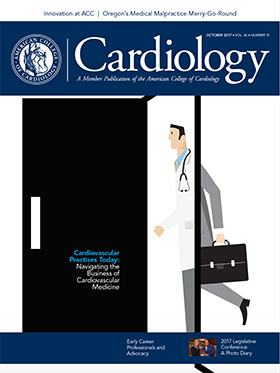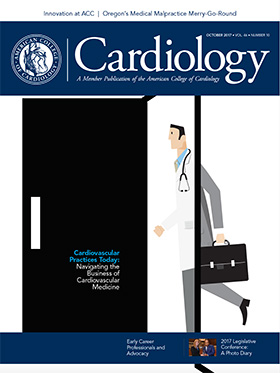Editor's Corner | Lifestyle, LCD-C and Risk Reduction

Recently we’re hearing more about the role of lifestyle in reducing heart disease risk. Recommendations for less meat and more vegetables in our diets, exercise as a component of the treatment regimen and programs to maintain normal body weight are gaining more recognition as an important and necessary part of medical therapy to reduce the risk of coronary artery disease.
While more data support the approach of an active lifestyle to reduce coronary disease risk, we continue to see new therapies designed to improve outcomes in patients who already have coronary disease. At ACC.17 we saw a number of interesting clinical trials that support our concepts about lipid metabolism and the role of LDL-C reduction in reducing the incidence of coronary events. The big news was the observation that evolocumab, a PCSK9 inhibitor, can reduce the number of coronary events in high-risk patients who have existing coronary disease.
We’d waited for several years, since the discovery of the lipid-lowering effects of PCSK9 inhibition, to learn whether the lower lipid levels achievable with PCSK9 inhibition translated into a reduction in coronary disease. Hints were there along the way. But it required a two-year randomized clinical trial to clearly show that lowering LDL-C with evolocumab plus intensive statin therapy had a clinical benefit. The effect was small but significant: 9.8 percent of patients who received evolocumab therapy had a coronary event, while 11.3 percent on intensive statin therapy alone had a coronary event. There was a striking reduction in LDL-C from 92 to 30 mg/dl in those receiving evolocumab. It appears that the striking reduction in LDL-C does have a beneficial effect in patients with existing coronary disease. Many lipidologists feel that this small difference will grow over time to provide a clear advantage to lowering LDL-C with a PCSK9 inhibitor.
While more data support the approach of an active lifestyle to reduce coronary disease risk, we continue to see new therapies designed to improve outcome in patients who already have coronary disease.
The temptation will be to skip oral therapy altogether and jump right to a PCSK9 inhibitor for therapy in even moderate- and low-risk patients with abnormal blood lipids. Many patients would view a once a month injection for therapy as a distinct advantage over a daily medication.
But within the din of the lipid trials, the interventional trials and of course the antiplatelet trials was a study that discussed observations in a population of native Bolivians (the Tsimane) who live a very simple lifestyle of hunting, gathering, fishing and farming, with very few of the amenities of western society. Their usual diet consists primarily of vegetables and fish. A high level of exercise is required to supply their daily sustenance.
A group of scientists and clinicians went to Bolivia to examine how this simple lifestyle affected the risk for development of atherosclerosis. They obtained consent to sample blood lipids and inflammatory markers. Importantly, they brought a CT scanner capable of accurately measuring coronary calcium scores to assess the extent of atherosclerosis in this population.
The results were striking: 85 percent of the Tsimane between ages 45 and 90 years had no coronary artery calcium and 13 percent had scores below 100. In those over 75 years, 65 percent had no calcium and four had calcium scores above 100. One would expect these individuals would have extremely low LDL-C levels that would explain their very low risk for coronary disease. But this wasn’t the case. The average LDL-C was 91 mg/dl and average HDL-C was 39.5 mg/dl. Their C-reactive protein levels suggested a mild increase in chronic inflammation.
Compelling evidence in favor of increased physical activity as a means to lower cardiovascular mortality also comes from the recently reported PURE study. The study demonstrated a significant reduction in cardiovascular mortality risk. Yet, the focus at cardiology meetings continues to be trials showing a reduction in cardiovascular events with a significant medication-induced reduction in LDL-C.
There is a larger task at hand than just maintaining normal lipid levels to reduce cardiovascular risk. If we look to the Tsimane, their average numbers for key risk factors were low: a BMI of 24, total cholesterol 155 mg/dl, LDL-C of 91 mg/dl, HDL-C of 40 mg/dl and triglycerides of 110 mg/dl. We are not challenged to achieve these numbers.
Lifestyle changes alone would be the best approach to reduce these risk factors. A diet balanced more towards vegetables and less towards meat and a moderate salt intake, along with a commitment to exercise every day. But, in our high-pressure world, medications are needed to achieve goals for lipids, blood pressure and blood sugar that would at least get us to the risk levels that would lower our risk for coronary artery disease.
Taking a pill every day — without lifestyle changes — is not the answer. A combination of diet and exercise, supplemented by medication as needed, will lower our cardiovascular disease risk. For the patient, this is a lifelong personal commitment. For the physician, this is a commitment to support a complete program of lifestyle management and not just an added medication.
Tweet this article: Tweet
 |
|
| Click the cover image above to read the latest issue of Cardiology in e-pub format or click here to read it on the web! | |
Keywords: ACC Publications, Cardiology Magazine, Coronary Artery Disease, Risk Factors, Vegetables, Triglycerides, Blood Glucose, C-Reactive Protein, Lipids, Lipid Metabolism, Ideal Body Weight, Blood Pressure, Cardiovascular Diseases, Body Mass Index, Antibodies, Monoclonal, Diet, Atherosclerosis, Life Style, Exercise, Inflammation, Agriculture, Cholesterol, Tomography, X-Ray Computed
< Back to Listings

